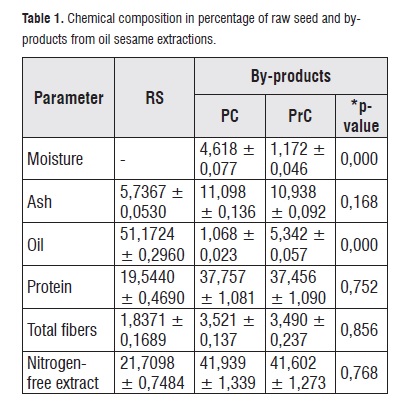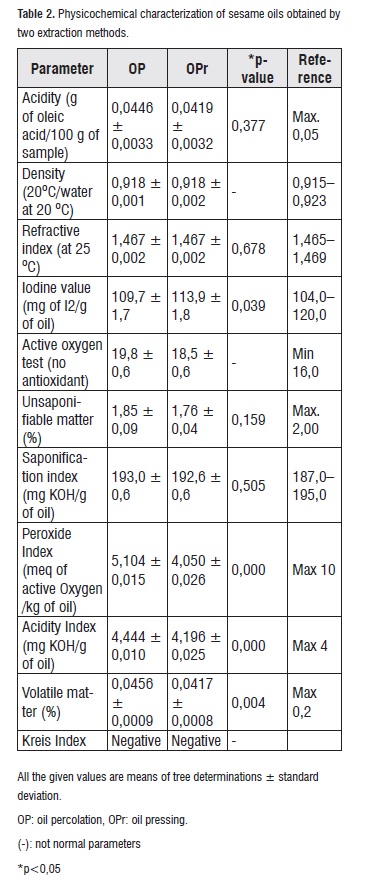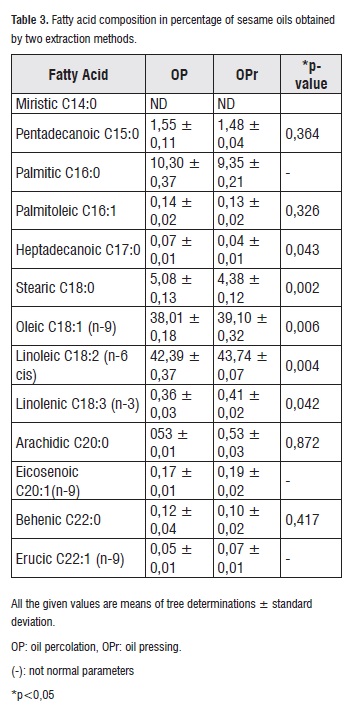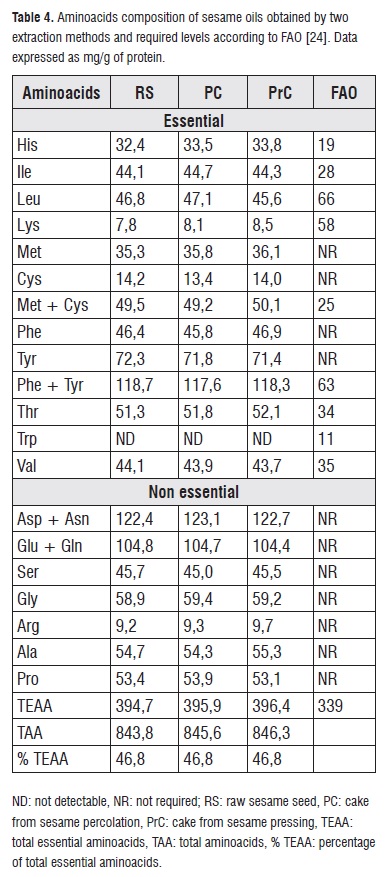Services on Demand
Journal
Article
Indicators
-
 Cited by SciELO
Cited by SciELO -
 Access statistics
Access statistics
Related links
-
 Cited by Google
Cited by Google -
 Similars in
SciELO
Similars in
SciELO -
 Similars in Google
Similars in Google
Share
Biotecnología en el Sector Agropecuario y Agroindustrial
Print version ISSN 1692-3561
Rev.Bio.Agro vol.14 no.1 Popayán Jan./June 2016
https://doi.org/10.18684/BSAA(14)10-18
DOI: http://dx.doi.org/10.18684/BSAA(14)10-18
COMPARISON OF TWO SESAME OIL EXTRACTION METHODS: PERCOLATION AND PRESSED
COMPARACIÓN DE DOS MÉTODOS DE EXTRACCIÓN DE ACEITE DE AJONJOLÍ:PERCOLACIÓN Y PRENSADO
COMPARAÇÃO DE DOIS MÉTODOS DE EXTRAÇÃO DE ÓLEO DE SÉSAMO:PERCOLAÇÃO E PRESSIONANDO
RICARDO BENÍTEZ-BENÍTEZ1,RUBÉN ANDRÉS ORTEGA-BONILLA2,JAIME MARTIN-FRANCO3
1Universidad del Cauca, Departamento de Química, Grupo Química de Productos Naturales. PhD. Popayán, Colombia.
2Universidad Autónoma de Madrid,Estudiante de doctorado. MSc. Madrid, España.
3Universidad del Cauca, Departamento de Química, Grupo Química de Productos Naturales. PhD.Popayán, Colombia.
Correspondencia: rbenitez@unicauca.edu.co
Recibido para evaluación: 27 de Mayo de 2015. Aprobado para publicación: 24 de Diciembre del 2015.
ABSTRACT
Two oil extraction methods, percolation and pressing, were applied on gold sesame seed (Sesamum Indicum L) and compared. Physicochemical properties and fatty acids profile were analyzed in both extracted oils using standard procedures. Raw seed and cakes from extractions were also analyzed by means of a proximate analysis and a profile of aminoacids. The extraction results were compared by the one-way analysis of variance followed by the Student test. Percolation method produced a higher sesame oil yield (98%) than pressing (94%), nonetheless, oil obtained by mechanical press was better from a nutritional point of view showing a higher content of polyunsaturated fatty acids. Peroxides and Kreis index indicated a high oxidative stability. Differences statistically significant were found between the percentages of moisture and fat of cakes, while the composition of aminoacids was similar. Methionine, phenylalanine and tyrosine were the aminoacids most available, and Leucine, Lysine and Tryptophan were the limitants.
KEY WORDS:Sesamum, Sesame oil, Percolation, Pressed.
RESUMEN
Se aplicaron y compararon dos métodos de extracción de aceite de ajonjolí, percolación y prensado, sobre semillas doradas (Sesamum Indicum L). En los aceites extraídos se evaluaron las propiedades fisicoquímicas y el perfil de ácidos grasos utilizando procedimientos estándar. Las semillas y tortas procedentes de las extracciones se analizaron por medio de análisis proximal y perfil de aminoácidos. Se compararon los resultados de la extracción a través de un análisis univariado seguido por la prueba T-student. El método de percolación produjo un rendimiento de extracción de aceite de ajonjolí (98%) más alto que el prensado (94%), sin embargo, el aceite obtenido por prensado fue mejor desde el punto de vista nutricional mostrando valores más altos de ácidos grasos poliinsaturados. Los índices de peróxidos y Kreis indicaron una alta estabilidad oxidativa. Se encontraron diferencias estadísticamente significativas entre los porcentajes de humedad y grasa de las tortas, mientras que la composición de aminoácidos fue similar. Metionina, fenilalanina y tirosina fueron los aminoácidos más disponibles, y leucina, lisina y triptófano los limitantes.
PALABRAS CLAVE:Ajonjolí, Aceite de ajonjolí, Percolación, Prensado.
RESUMO
Foram aplicados e comparados dois métodos de extracção de óleo de sésamo, percolação e prensagem, sobre sementes douradas (Sesamum indicum L.). Nos óleos extraídos se avaliaram as propriedades físico-químicas e o perfil de ácidos gordos utilizando procedimentos padrões. As sementes e os resíduos das extracções foram analisados por médio de análises proximal e perfil de aminoácidos. Os resultados da extracção foram comparados através duma análise univariado seguida pelo teste T-student. O método de percolação produz um rendimento de extracção de óleo de sésamo (98%) mais alto do que a prensagem (94%), porém, o óleo obtido pela prensagem foi melhor desde o ponto de vista nutricional mostrando valores mais altos de ácidos gordos polinsaturados. Os índices de peróxidos e Kreis indicaram uma alta estabilidade oxidativa. Encontraram-se diferenças estatisticamente significativas entre as percentagens de humidade e gordura dos resíduos de extracções, enquanto a composição dos aminoácidos foi similar. Metionina, fenilalanina, e tirosina foram os aminoácidos mais disponíveis, e leucina, lisina e triptofano presentaram menos quantidade.
PALAVRAS-CHAVE:Sesamum, Óleo de sésamo, Percolação, Prensadas.
INTRODUCTION
Oil from sesame (Sesamum indicum L.) is currently a world recognized gourmet edible oil due to its long half-life and rich content in lignans (sesamin, sesamol, sesamolin), essential fatty acids, tocopherols and tocotrienols which have reported antioxidant, anticarcinogenic and antimicrobial activities [1-6].
Sesame seed is within the first five oleaginous harvested in Colombia. Between 2.007 and 2.011, around 2.202 tonnes per year were produced with a depletion in the last years due to its low national commercialization [7] as a result of presence in the market of products with a high processing and a scarce extraction technology that preserve their properties and provide a stable product. Sesame oil is the major product obtained from seeds (about 45 50% by weight) and it is especially useful for culinary purposes and cattle feed due to its characteristic flavor [8, 9]. In this context, the oil extraction is a very important process for industry. Up to date, the literature describes the conventional (chemical, mechanical) [10] and innovative (enzymatic, supercritical) [11, 12] extraction methods. The first ones include the use of organic solvents on powdered seeds and subsequent recovery of the solvent by distillation or use of hydraulic or screw press, while the second ones the use of pressurized fluids such as CO2 and propane or enzymes that enable the separation of oil and residue; one of the main differences between them is the extent of solvent in the products obtained. However, the selection of the extraction method essentially depend on oil quality required but also experimental conditions, costs and environmental impact sought. The characteristics and quality of extracted oil can be evaluated by determination of its physicochemical parameters, type and amount of fatty acids and proximate analysis. Moreover, cake is a sub-product in the extractions processes, hence the physicochemical analysis is an additional tool to determine the efficiency of oil extraction and fate of these by-products. Despite the production of sesame oil is not well consolidate in Colombia, this might have successful perspectives in the national and international market because of its beneficial health effects. However, scientific support that encourages the increase of production for the commercialization process of oilseed chain in Colombia from point view of its quality is lacking. In this sense, the aim of this study was compare the two most common conventional sesame oil extraction methods used: percolation and pressing through assessment of extracted oils and derived cakes from the determination of fatty acids and aminoacids profiles, respectively.
METHOD
Chemicals and material
All the chemicals, solvents and acids were purchased from Merck and Sigma–Aldrich Co. The solvents and chemicals were of analytical grade and extra pure in nature. Commercial Sesamum Indicum L seeds were purchased from the municipalities of Ovejas and El Carmen in the department of Bolívar in the North of Colombia. Seeds were dried at 55°C for 4 hours, after that kept at 20°C until further analysis.
Proximate analysis of Sesamum Indicum L seeds
The dried seeds were used to estimate their proximate composition according to AOAC [13]. The moisture content was determined by dehydration at 100-105°C oven with a fix pressure until a constant weight was reached (AOAC 950.43). The total ash content was measured gravimetrically in a blast furnace at 550°C for 4 hours as g of ash/100 g of dried sample (AOAC 991.36). Crude lipids of S. Indicum were extracted using the soxhlet apparatus with hexane for 4 hours (AOAC 920.153) and determined gravimetrically. Crude protein was estimated by application of AOAC with slight modifications (AOAC 968.06) through an acid digestion and nitrogen distillation using Kjeldahl method. The crude fiber content was assessed according to AOAC enzymatic gravimetric method (AOAC 962.09). Finally, nitrogen-free extract was computed making a difference.
Oil extraction methods
Two conventional methods were applied on gold dried sesame seeds to extract the oil. Percolation process was carried out using 1000 g of seeds powder. Briefly, hexane (4,5 L) was added to the powder, which was extracted at room temperature. Then, mixture was filtered and the no polar extract and cake (PC) were differentially obtained. The extract was concentrated by rotatory evaporation to obtain the gold sesame oil (OP). While, press sesame oil extraction was performed in a hydraulic press (Shimadzu UDH 50) at room temperature. Both sesame oil (OPr) and cake (PrC) were obtained. Oils extracted by the two methods were stored until further analysis at 4°C.
Oil characterization
Physicochemical analyses. Acidity and viscosity were determined from free fatty acid content and measurement of time and flow rate. Iodine, saponification, acidity, peroxides and refractive index and density were determined according to AOAC standards methodologies 920.159, 920.160, 924.48, 965.33, 921.08 and 920.212, respectively [13]. Test of active oxygen and volatile matter were evaluated following the recommended practices (AOCS Cd 12 – 57 and ISO 662/ 1998) [14]. Kreis test was based on the production of red colour as a consequence of the reaction between phloroglucinol and epihydrin aldehyde, a compound present in rancid oils.
Fatty acid analysis
Fatty acid extracted by percolation and pressing from sesame oils were methylated and analyzed using gas chromatography according to standardized method proposed by the company ACEGRASAS S.A. Lipids were extracted from oils samples (20 mg) using 3 mL of a mixture of chloroform: methanol (1:1) with stirring for 1,5 h. Resulting mix was centrifuged at 4000 x g for 15 min. Supernatant was diluted with chloroform (1mL) and distilled water (2 mL) and mixed and centrifuged at 4.000 x g for 5 min. Dehydrated acetone (0,5 mL) was added to chloroformic phase and evaporated at 39°C. Samples were dried under nitrogen atmosphere, then re-dissolved with 3 mL of HCl 5% in methanol and stored in vials which were submerged in a water bath at 85°C for 150 min. A double extraction with hexane (1 mL) led to collect the fatty acid methyl esters which were dissolved in chloroform until further chromatographic analysis.
A gas chromatograph Hewlett Packard model 5890 series II gas chromatograph (Hewlett Packard Co., Palo Alto, CA, USA) equipped with a flame ionization detector and a 60 m × 0,32 id column (Supelco Inc., Bellefonte, PA) was employed. The nitrogen gas carrier flow was 0,8 mL/min. The injector and detector temperatures were 270°C and 310°C, respectively. The column was operated at 180–250°C. The chromatogram peaks were assigned manually on the basis of comparison with the reference standards (GN 90001 RAL, Spain). Fatty acids were expressed as percentage of total fat.
Cakes characterization
Proximate analysis. Samples were assessed as described above for sesame seeds.
Amino acids profile. Aminoacids contained in the residues were analysed and quantified by application of Waters Pico-Tag method (Millipore Inc., Milford, MA) according to described in Pico-Tag Amino Acid Analysis System Operator's Manual [15] which consists in three stages: 1) Hydrolysis of protein, 2) Pre-column derivatization reaction of aminoacids, and 3) Separation and quantification by chromatography. In the first stage, methionine sulfone was added to the sample as intern pattern, then a hydrolysis with vapour of HCl 6N into a sealed vial at 112°C for 24 h. Vacuum drying was done and sample was mixed with 15 mL of methanol:water:trimethylamine 2:2:1 and drying again. In the second stage, sample was derivatized with 20 µL of a mixture of methanol:trimethylamine:water:phenylisothiocyanate (PITC) 7:1:1:1; then, resulting sample was diluted with 200 µL of diluting solution Pico-Tag and filtered through syringe filter (Whatman Inc, Clifton, NY) size 0,2 µm. Finally, derivatized aminoacids were analysed by HPLC.
The chromatographic analysis of the residue was performed on a phase reverse column Pico-Tag Waters HPLC 3,9 x 150 mm equipped with automatic auto sampler, diode array detector and Milenio 32 software. The operating conditions were as follows: mobile phase flow-rate 1.0 mL/min, Λ =254 nm and column temperature at 36°C. Each test was started with a linear gradient from 100% eluent A mobile phase (acetate: acetronitrile, 9,35:6,5 being acetate a mixture of sodium acetate 140 mM with tri-ethylamine adjusted with acetic acid at pH 5,9) between 0 and 1,6 min, to 54% of the starting mobile phase and 46% of the elution mobile phase B (acetonitrile: water, 6:4) over 13 min, until 100% of eluent B between 13,2 and 15 min.
The chromatogram peaks were identified by comparison with the reference standard solution AA STD-18 (Sigma).
Statistical analysis
Measurements of physicochemical parameters of oils and cakes, oils fatty acids composition and proximate of seeds and cakes were made in triplicate and results were expressed as mean ± SD (standard deviations). Shapiro-Wilk and Levene tests were employed to demonstrate the data normality and homoscedasticity. Statistical significance was analysed by the one-way analysis of variance (ANOVA) followed by the Student test (for independent samples). p values below 0,05 were considered significant.
RESULTS
Extraction yield and physicochemical characteristics of oils
An ideal extraction process (which considers quality product and environmental impact) for commercial production of oils has not yet been reported. However, mechanical and solvent extractions are currently the most used methods by small, medium and large scale due to their yields.

Table 1 presents the approximate chemical composition of raw sesame seed (RS) and cakes obtained after percolation (PC) and pressing (PrC) extractions. As it was expected, RS showed a high content of oil (overcomes 50%) whilst cakes were rich in protein (around 37%). Percolation extraction showed an oil yield higher than pressing (approx. 98% vs. 94%, respectively). The difference could be attributed to the extraction time, heat generated during friction and oil cake losses during handling in pressing method. The amount of hexane-oil extracted was framed in the ranges (41-58%) reported for sesame seeds in the literature [9, 16-21]. PC had a significantly higher moisture content than PrC as a result of difficult removal of bound and structural water over drying stage. The rest of chemical variables did not show significant variation between PC and PrC.
Effect of extraction method on physicochemical properties for sesame oil are illustrated in Table 2. Both extracted oils fulfilled with the physicochemical parameters established for commercialization of sesame oil in Colombia [22] except the acidity index for which value found is slightly above.

Iodine values found were significantly higher than determined in Sudan raw sesame seeds and industrial by-products obtained after dehulling and roasting analyzed by solvent extraction. Hence, our results suggest that Colombian sesame oil contain higher levels of oleic and linoleic acids than African.
Percolation method yield an oil with a peroxide index significantly higher than that from pressing. These values were also higher than the hexane extracted sesame oil by Latif and Anwar (2.011). Similar findings are noted for acidity index and volatile matter, i.e. significantly higher (p<0,05) values were determined by percolation as against the pressing extraction. Percolation lower values of volatile matter in oil from pressing could be explained by increasing of temperature from mechanical friction that contribute to the lost during process. Regarding to the rest of oils characteristics, there were no significant difference (p>0,05) between percolation and pressing extraction. Assayed oils present a greater content of saponifiable and unsaponifiable matter than hexane-oilseed extracted by Latif and Anwar (2.011) but free fatty acid content was much less (0,54%).
Fatty acid composition
Fatty acid composition of the extracted oils from percolation and pressing is presented in Table 3. The most abundant fatty acids in oils were linoleic (∼43%) and oleic (∼39%) as unsaturated, and palmitic (∼10%) and stearic (∼5%) as saturated. Extracted oil percolation showed significantly (p<0,05) higher values of saturated fatty acids (stearic and heptadecanoic) than those from pressing. On the other hand, the content of predominant unsaturated fatty acids (oleic C18:1/ ω-9, linoleic C18:2/ ω-6 and linolenic C18:3/ ω-9) was significantly (p<0,05) higher in oils from pressing extraction. Oleic percentage is comparable to value contented in oil from Japanese [23], Indian [21], Brazilian [18] and Pakistan [20] seeds (∼38%) but it is lower than reported for that from Sudan seeds (∼44%) [9]. Linoleic content in tested oils resulted lower than Japanese, Indian and higher than Sudan. Composition in linolenic acid was comparable to oil from Indian and Brazilian seeds.

Chemical composition of seed and cakes
Proximate analysis of raw sesame seed from South Colombia (see Table 1) showed the typical composition reported by other authors demonstrating no remarkable differences by origin. Oil content (51,2%) was practically the same to that determined in seeds from Africa (52,2%) [9] and Canada (52,0 %) [16], slightly higher than those from Korean [19] and lower than Indian (54,72%) [21]. As expected, extraction of oil from sesame seed led to increases in other constituents in the cakes, specifically in protein content, which increased from 19,54% in the RS to ∼37% in PC and PrC. Protein content of tested seeds was comparable to value found by Bukya and Vijayakumar (2.013) and almost 20% lower than determined in others investigations [9, 16, 17]. With respect to the rest of composition, raw seeds are distinguished by ash content but overall do not differ from that reported in the literature.
The PC had a significantly (p<0,05) high moisture (4,62 %) compared to PrC. Fat content of PrC was significantly (p<0,05) greater than PC. The proximate composition of the obtained sesame cakes are not in accordance with the previously reported in [17]; different levels of moisture, protein, fiber, ash and an oil content almost five times below are described, probably due to repeated extractions with α-hexane.
Aminoacids profile of cakes
Essential aminoacid contents present in RS, PC and PrC exceeded to recommended daily ingestion for an adult, except for Leu, Lys and Trp, see Table 4. This fact implies, a fortification with these aminoacids in both cakes would be needed in order to supply 30 mg/g of Leu, 86 mg/g of Lys and 11 mg/g of Trp. In this sense, it is recommended to mix these derived of seeds with cereal in order to supplement tryptophan and to avoid deficiency in diets or products lacking animal proteins. Lysine is evidenced as limiting aminoacid according to requirements defined by FAO [24].

The cake results did not differ dramatically from raw seed and from each other extraction method indicating that there was not a degradation of these compounds. Our results suggest that sesame cakes from conventional extraction methods require a greater enrichment sesame flour which is deficient in Lys [25].
CONCLUSIONS
Results reported here show the sesame oil obtained from pressing extraction as a better oil edible from a nutritional point of view by its higher content of essential fatty acids (ω-3, ω-6) and lower content of the main saturated acids than those found in oil from percolation. However, the increasing of temperature caused by mechanical friction reduced significantly oil quality by decreasing the volatile compounds. Regarding to oxidation, both extracted presented high oxidative stability. The extraction method not only affect the oil extraction yield and quality, but also the quality of the sesame protein obtained as a residue, which has also a considerable interest in the valorization of sesame seed. Aminoacids profile of cakes exhibited comparable values between the extraction methods, statistical analysis was lacking.
REFERENCIAS
[1] AYYILDIZ, H.F., TOPKAFA, M., KARA, H. and SHERAZI, S.T.H. Evaluation of Fatty Acid Composition, Tocols Profile, and Oxidative Stability of Some Fully Refined Edible Oils. International Journal of Food Properties, 18(9), 2015, p. 2064-2076. [ Links ]
[2] DAR, A.A., VERMA, N.K. and ARUMUGAM, N. An updated method for isolation, purification and characterization of clinically important antioxidant lignans - Sesamin and sesamolin, from sesame oil. Industrial Crops and Products, 64, 2015, p. 201-208. [ Links ]
[3] LIU, C.T., PERIASAMY, S., CHANG, C.C., MO, F.E. and LIU, M.Y. Sesame oil therapeutically ameliorates cardiac hypertrophy by regulating hypokalemia in hypertensive rats. Journal of Parenteral and Enteral Nutrition, 38(6), 2014, p. 750-757. [ Links ]
[4] MONTEIRO, É., CHIBLI, L., YAMAMOTO, C., PEREIRA, M., VILELA, F., RODARTE, M., DE OLIVEIRA-PINTO, M., DA PENHA-HENRIQUES DO AMARAL, M., SILVÉRIO, M., DE MATOS-ARAÚJO, A., DA LUZ-ANDRÉ DE ARAÚJO, A., DEL-VECHIO-VIEIRA, G. and DE SOUSA, O. Antinociceptive and Anti-Inflammatory Activities of the Sesame Oil and Sesamin. Nutrients, 6(5), 2014, p. 1931-1944. [ Links ]
[5] PATHAK, N., RAI, A.K., KUMARI, R. and BHAT, K.V. Value addition in sesame: A perspective on bioactive components for enhancing utility and profitability. Pharmacognosy Reviews, 8(16), 2014, p. 147-155. [ Links ]
[6] XU, H.C. and WANG, M.Y. Effect of flavonoids from Lotus (Nelumbo nuficera Gaertn) leaf on biochemical parameters related to oxidative stress induced by exhaustive swimming exercise of mice. Biomedical Research (India), 25(1), 2014, p. 1-5. [ Links ]
[7] CORPORACIÓN PBA. Cadenas Productivas. Cadena de Ajonjolí. Redes virtuales de organizaciones de pequeños productores [online]. 2014. Disponible: http://cadenasproductivas.ning.com/group/cadena-productiva-de-ajonjoli [citado:7 Enero de 2015] [ Links ].
[8] ACEVEDO, D., MONTERO, P.M. and MARRUGO, Y.A. Study of the rheological properties of artisanal and technified pastas of oily sesame (Sesamum indicum) grown in Zambrano-Bolívar (Colombia). Informacion Tecnologica, 25(4), 2014, p. 73-78. [ Links ]
[9] ELLEUCH, M., BESBES, S., ROISEUX, O., BLECKER, C. and ATTIA, H. Quality characteristics of sesame seeds and by-products. Food Chemistry, 103(2), 2007, p. 641-650. [ Links ]
[10] ROSTAMI, M., FARZANEH, V., BOUJMEHRANI, A., MOHAMMADI, M. and BAKHSHABADI, H. Optimizing the extraction process of sesame seed's oil using response surface method on the industrial scale. Industrial Crops and Products, 58, 2014, p. 160-165. [ Links ]
[11] FANG, X. and MOREAU, R.A. Extraction and demulsification of oil from wheat germ, barley germ, and rice bran using an aqueous enzymatic method. JAOCS, Journal of the American Oil Chemists' Society, 91(7), 2014, p. 1261-1268. [ Links ]
[12] KING, J.W. Modern supercritical fluid technology for food applications. Annual Review of Food Science and Technology, 5(1), 2014, p. 215-38. [ Links ]
[13] HORWITZ, W. Official methods of analysis of AOAC International. Gaithersburg (USA): AOAC International, 2000, 69 p. [ Links ]
[14] BRÜHL, L. Official Methods and Recommended Practices of the American Oil Chemist's Society, Physical and Chemical Characteristics of Oils, Fats and Waxes. Lipid/Fett, 99(5), 1997, p. 197-251. [ Links ]
[15] WATERS. Manual No. 88140: PICO-TAG Amino Acid Analysis System Operator's Manual, Waters Chromatography Division Millipore Corporations. Milford (Massachusetts): 2005, 4 p. [ Links ]
[16] ACHOURI, A., NAIL, V. and BOYE, J.I. Sesame protein isolate: Fractionation, secondary structure and functional properties. Food Research International, 46(1), 2012, p. 360-369. [ Links ]
[17] BUKYA, A. AND VIJAYAKUMAR, T.P. Properties of industrial fractions of sesame seed (Sesamum indicum L.). International Journal of Agricultural and Food Science, 3(3), 2013, p. 86-99. [ Links ]
[18] CORSO, M.P., FAGUNDES-KLEN, M.R., SILVA, E.A., CARDOZO-FILHO, L., SANTOS, J.N., FREITAS, L.S. and DARIVA, C. Extraction of sesame seed (Sesamun indicum L.) oil using compressed propane and supercritical carbon dioxide. The Journal of Supercritical Fluids, 52(1), 2010, p. 56-61. [ Links ]
[19] KIM, J.H., SEO, W.D., LEE, S.K., LEE, Y.B., PARK, C.H., RYU, H.W. and LEE, J.H. Comparative assessment of compositional components, antioxidant effects, and lignan extractions from Korean white and black sesame (Sesamum indicum L.) seeds for different crop years. Journal of Functional Foods, 7, 2014, p. 495-505. [ Links ]
[20] LATIF, S. and ANWAR, F. Aqueous enzymatic sesame oil and protein extraction. Food Chemistry, 125(2), 2011, p. 679-684. [ Links ]
[21] ZOUMPOULAKIS, P., SINANOGLOU, V.J., BATRINOU, A., STRATI, I.F., MINIADIS-MEIMAROGLOU, S. and SFLOMOS, K. A combined methodology to detect ?-irradiated white sesame seeds and evaluate the effects on fat content, physicochemical properties and protein allergenicity. Food Chemistry, 131(2), 2012, p. 713-721. [ Links ]
[22] COLOMBIA. MINISTERIO DE SALUD Y PROTECCIÓN SOCIAL. Diario Oficial Resolución 0002154 Capítulo VII: Requerimientos fisicoquímicos de aceites. Bogotá (Colombia): 2012, p. 1-32. [ Links ]
[23] YOSHIDA, H. Composition and quality characteristics of sesame seed (Sesamum indicum) oil roasted at different temperatures in an electric oven. Journal of the Science of Food and Agriculture, 65(3), 1994, p. 331-336. [ Links ]
[24] FAO/WHO/UNU. Energy and protein requirements. Report of a joint FAO/WHO/UNU expert consultation. Geneva (Italy): WHO technical report series, 1985. [ Links ]
[25] NASCIMENTO, E., CARVALHO, C., TAKEITI, C., FREITAS, D. and ASCHERI, J. Use of sesame oil cake (Sesamum indicum L.) on corn expanded extrudates. Food Research International, 45(1), 2012, p. 434-443. [ Links ]













